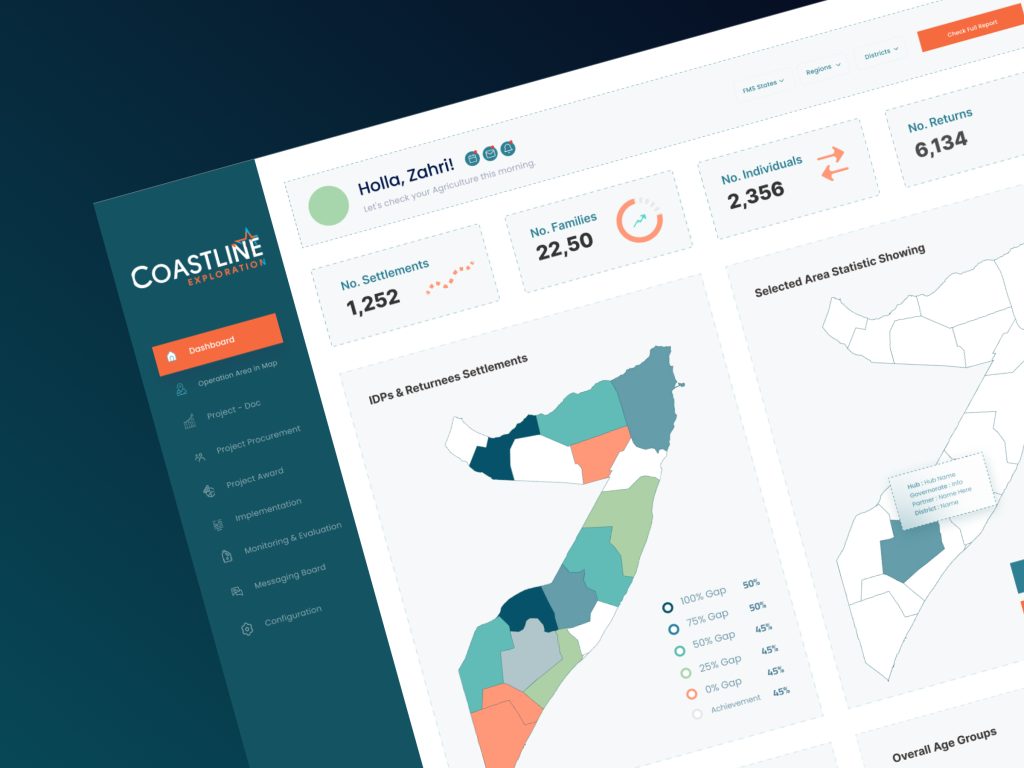Petroleum Analytics Dashboard UIUX Design
We worked on a UI/UX project called Petroleum Sourcing for Coastline Corporation in 2022. The Somali government published a tender, and Coastline Corporation won the bid. The objective was to build a platform where users could easily monitor all petroleum sourcing data in one place.
We followed our UX process to create a user-friendly platform tailored to the target audience. Our process included the following steps:
- Brainstorming based on the project requirements
- Building Personas to represent key user groups
- User Research to gather insights
- Rough User Flows to map out the user journey
- Architecture Design to structure the platform
- High-Fidelity UI Design to create a polished interface
Results & Outcomes:
- Enhanced organizational efficiency
- Easy-to-use, time-saving platform
- Simplified data recording and retrieval
- Modern UI design, as requested by the client

Brainstorming Based on Project Requirements involves gathering the project team to discuss and generate ideas aligned with the client’s needs and goals. This phase is crucial for understanding the project’s scope, identifying challenges, and exploring potential solutions. For the Petroleum Sourcing project, we analyzed the tender requirements, considered the target audience, and collaborated to outline the key features and functionalities. The brainstorming session helped us align our vision with the client’s expectations, ensuring that the design approach met both user and business objectives.

Building Personas to Represent Key User Groups is the process of creating fictional profiles that embody the characteristics of the platform’s primary users. These personas are based on user research and insights, reflecting demographics, behaviors, motivations, and pain points. For the Petroleum Sourcing project, we developed personas to understand the needs of different stakeholders, such as government officials, analysts, and corporate decision-makers. By using personas, we were able to tailor the user experience, ensuring the platform addressed specific requirements and provided a seamless, intuitive interface for each user group.
User Research to Gather Insights is the process of collecting data and feedback directly from potential users to better understand their needs, behaviors, and challenges. For the Petroleum Sourcing project, we conducted interviews, surveys, and observations to gain valuable insights into how stakeholders interact with petroleum data. This research helped us identify pain points and opportunities for improvement, guiding the design decisions and ensuring the platform was both functional and user-friendly. The insights from user research were crucial in building a system that aligned with the users’ expectations and workflow.

Rough User Flows to Map Out the User Journey involves sketching the step-by-step paths that users will take to complete tasks within the platform. For thPetroleum Sourcing project, we created rough user flows to visualize how different personas would navigate through the system, from logging in to accessing petroleum data and generating reports. These initial drafts helped us understand the key touchpoints and interactions, allowing us to identify potential bottlenecks or confusion points early on. This stage ensured the platform’s structure was intuitive, guiding users smoothly through their tasks.

Architecture Design to Structure the High-Fidelity is the process of organizing the system’s overall framework, defining how different components and data will interact. For the Petroleum Sourcing project, we designed the platform’s architecture to ensure seamless data flow and efficient access to petroleum sourcing information. This involved structuring databases, setting up user permissions, and determining how various modules—such as data entry, reporting, and monitoring—would function together. A well-planned architecture was essential for creating a scalable, reliable, and user-friendly system that met both the technical and user needs.



High-Fidelity UI Design to Create a Polished Interface involves designing detailed, visually accurate screens that closely resemble the final product. For the Petroleum Sourcing project, we translated the rough wireframes and user flows into high-fidelity designs, incorporating the client’s branding, modern aesthetics, and user-friendly elements. This phase focused on fine-tuning the visual details, such as typography, color schemes, and interactive components, to create a clean and intuitive interface. The polished design provided a clear representation of the final user experience, ensuring the platform was both functional and visually appealing to users.








